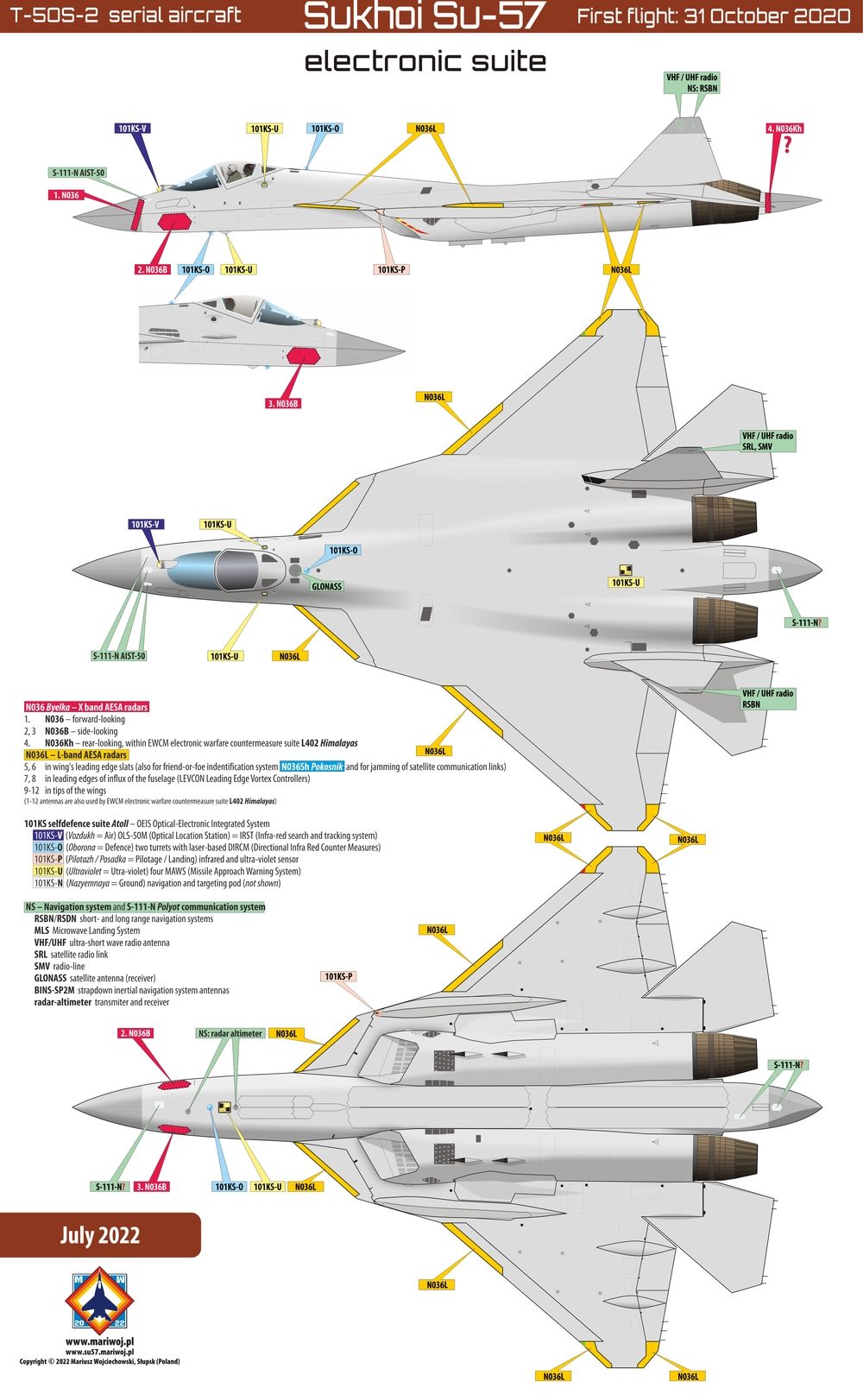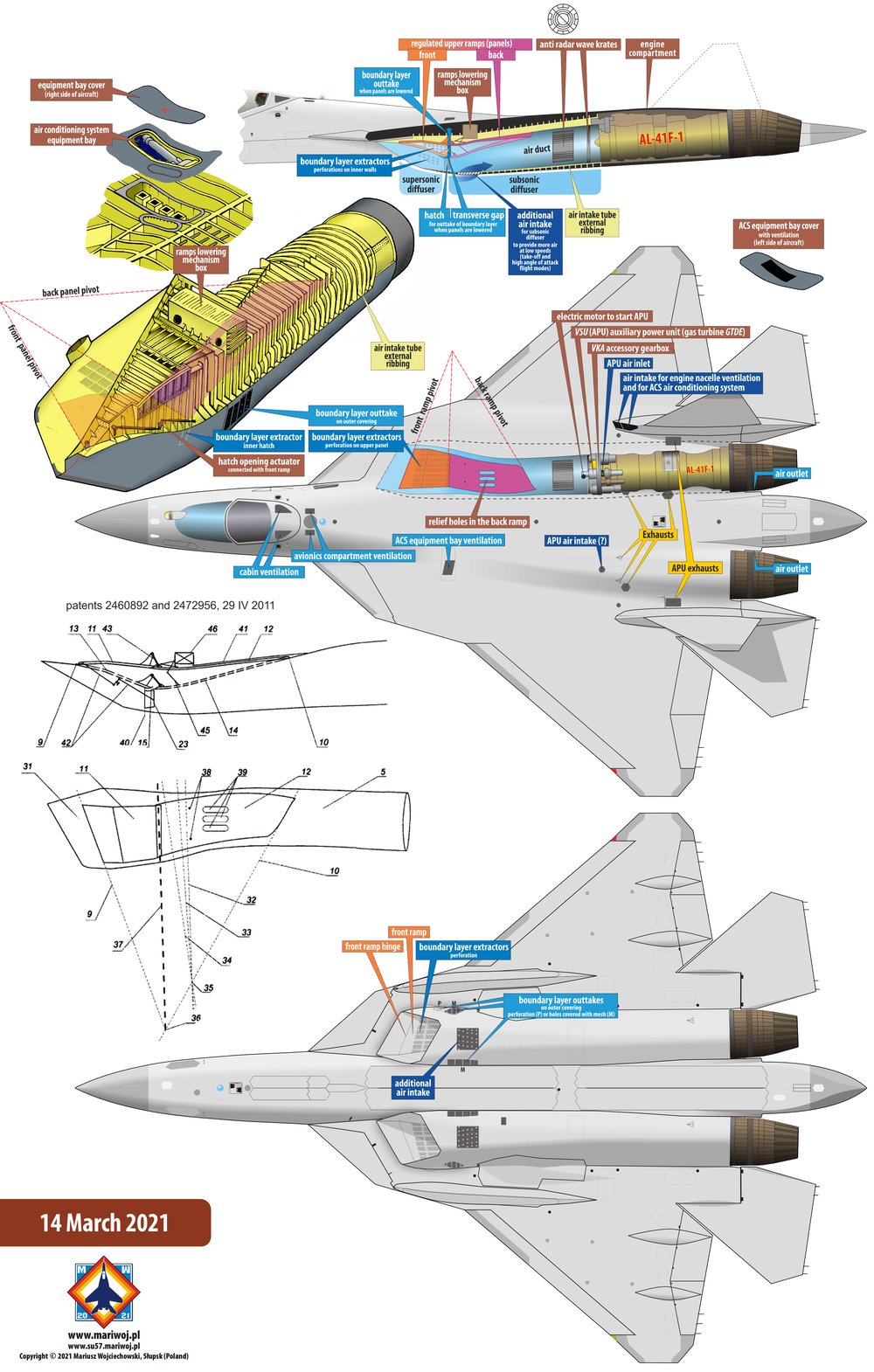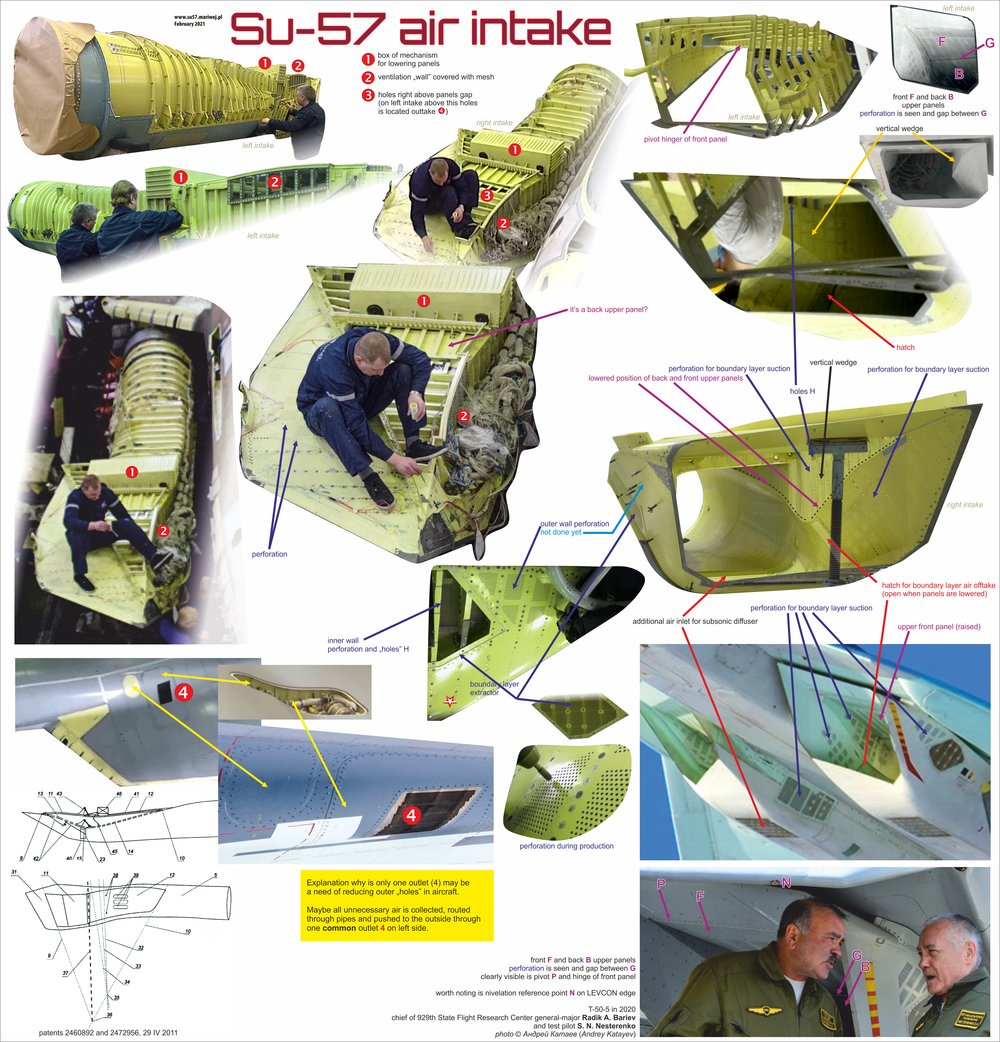Prototypes
|
| Izdyelye (product) |
Number |
Type |
First flight |
Camouflage |
|
|
T-50-0 KPO
|
none
|
airframe for static strength tests
Т-50-0 КПО конструктивно-подобный образец
|
Assembly begin in November 2006 in Komsomolsk-on-Amur KnAAPO plant (now KnAAZ).
Ready June 2009
|
not painted
|
|
T-50-KNS
|
none
|
airframe for ground test
Т-50-КНС комплексный наземный стенд
|
Assembly begin in December 2007 in KnAAPO plant.
Ready 24th December 2009
22nd January 2010
Syergyei Bogdan
PAK-FA first high-speed taxiing with nosewheel lift off the ground for few seconds while running, parachute was also deployed.
|
overall light bluegrey.
|
|
T-50-1
|
51
later
051
|
1st flyable prototype
|
29th January 2010 11:19 local time
Syergyei Bogdan
KnAAPO plant Dzemgi airfield
28th January 2010 attempt to first flight was interrupted due to problems with the steering controls and the brake system.
|
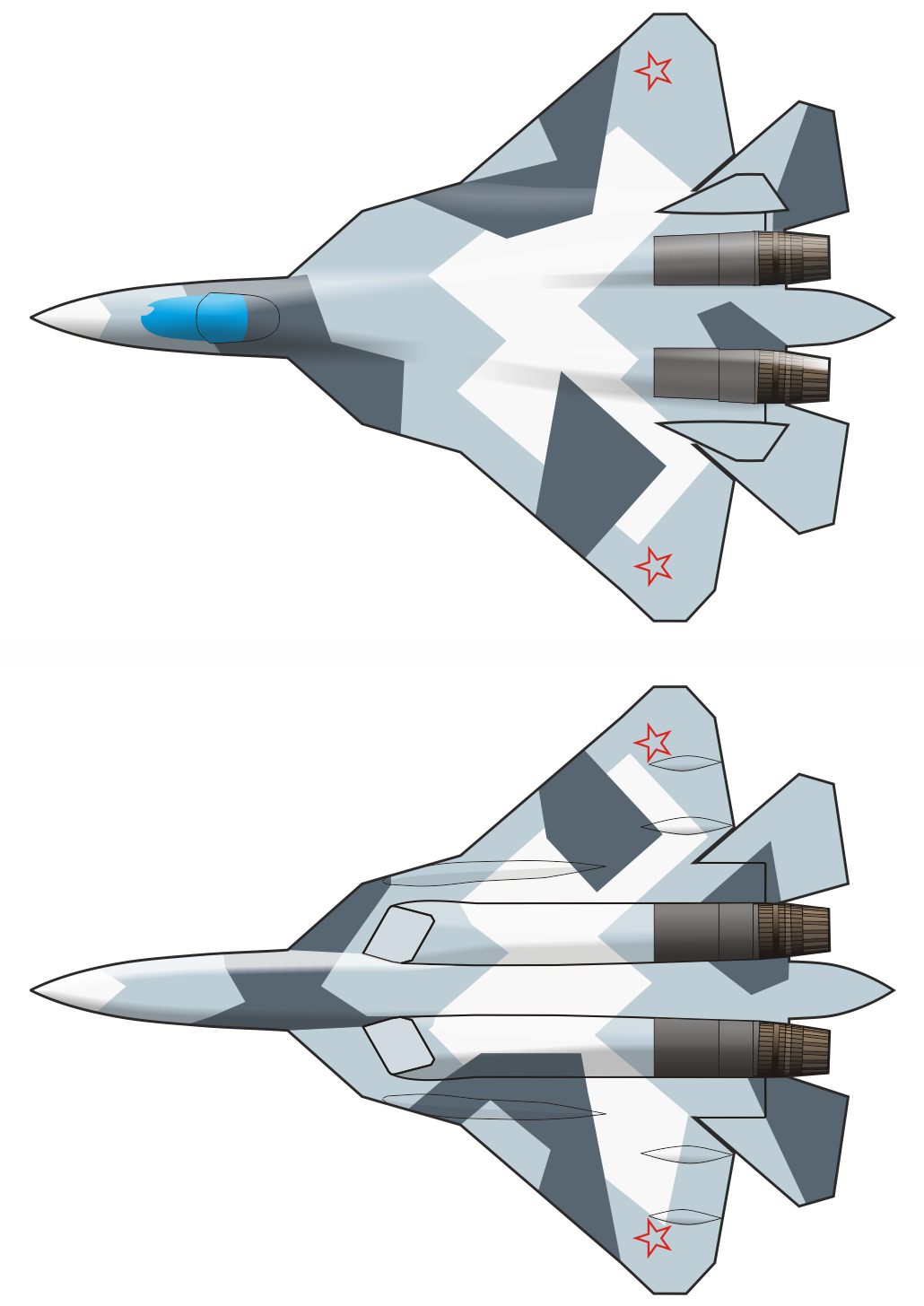
Disruptive camouflage pattern painted in April 2010. Main feature of this scheme is big white letter M and simplified Russian markings (a star) in low-visibility version.
 Spin recovery parachute installed in August 2011. Never used. Spin recovery parachute installed in August 2011. Never used.
|
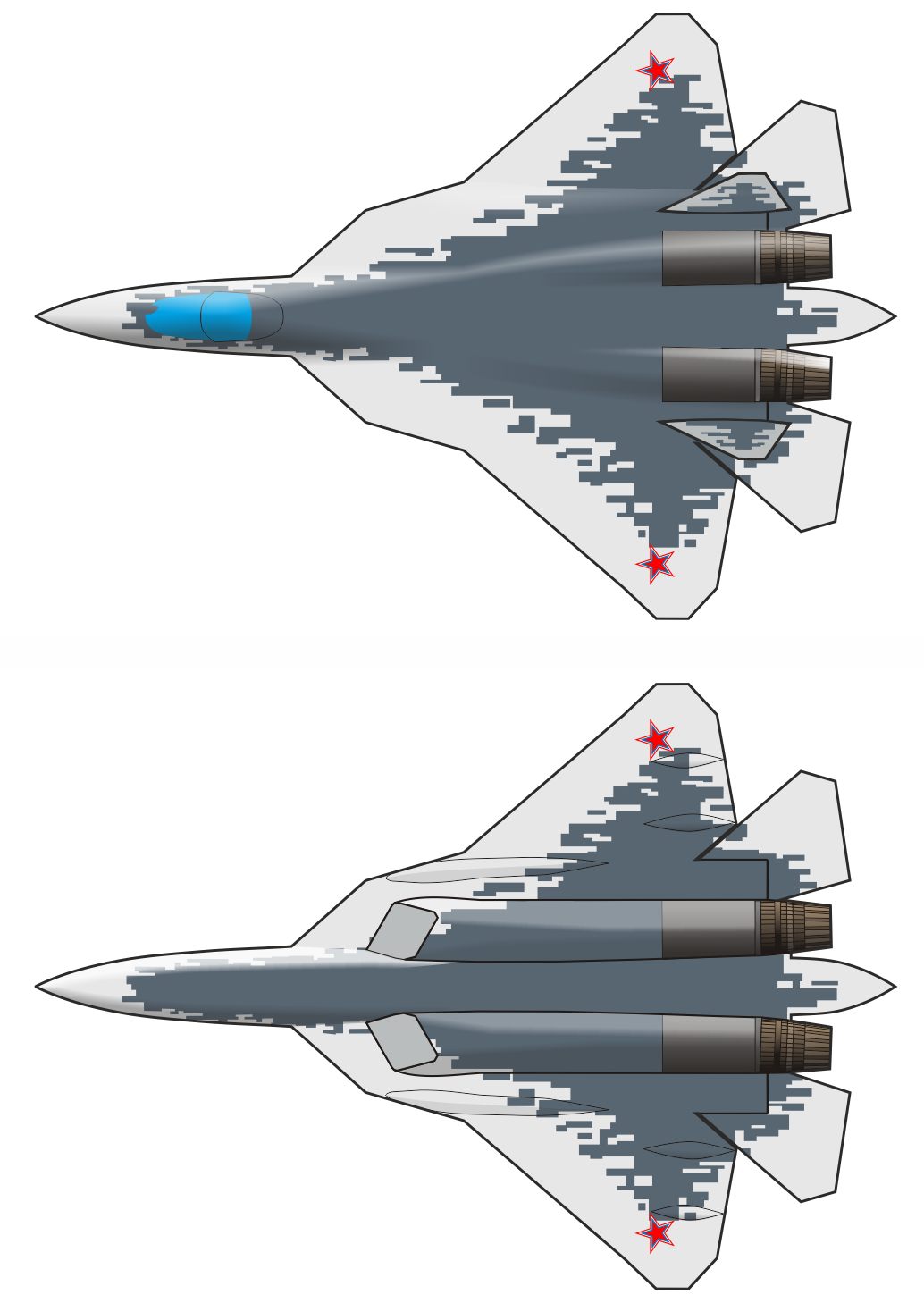
In April or May 2018, before MAKS-2018, disruptive camouflage was replaced on top and bottom by pixel scheme on lightgrey background.
|
|
T-50-2
|
52
later
052
|
2nd flyable prototype
|
3rd March 2011
Syergyei Bogdan
|

Disruptive camouflage pattern almost the same as T-50-1, painted in July or August 2011.
|
 5th December 2017 prototype called Т-50ЛЛ (T-50LL Flying Laboratory) piloted by Syergyei Bogdan had performed first test flight with installed one new-generation engine “product 30”, intended to replace first stage engine изделие 117, АЛ-41Ф1 (product 117, AL-41F1). Engine will be produced by ОДК Объединенная двигателестроительная корпорация (United Engine Building Corporation) which integrated all main Russian engine's producers: Moskov Machine Production Enterprise, Klimov, UMPO, Kuznyetsov, Saturn, Aviadvigatyeli, Star, NPP Motor, Perm Engine Plant, Metallist-Samara. 5th December 2017 prototype called Т-50ЛЛ (T-50LL Flying Laboratory) piloted by Syergyei Bogdan had performed first test flight with installed one new-generation engine “product 30”, intended to replace first stage engine изделие 117, АЛ-41Ф1 (product 117, AL-41F1). Engine will be produced by ОДК Объединенная двигателестроительная корпорация (United Engine Building Corporation) which integrated all main Russian engine's producers: Moskov Machine Production Enterprise, Klimov, UMPO, Kuznyetsov, Saturn, Aviadvigatyeli, Star, NPP Motor, Perm Engine Plant, Metallist-Samara.

At the end od 2020 prototype T-50-2 is very fatigue, with parts “borrowed” from other prototypes and traces of reworking. Aircraft perfomed a new test flights, still with only one engine product 30.
|
|
T-50-3
|
053
|
3rd flyable prototype
|
22nd November 2011
Syergyei Bogdan
|

Disruptive camouflage pattern almost the same as T-50-1 and T-50-2 was painted probably in March 2012.
|
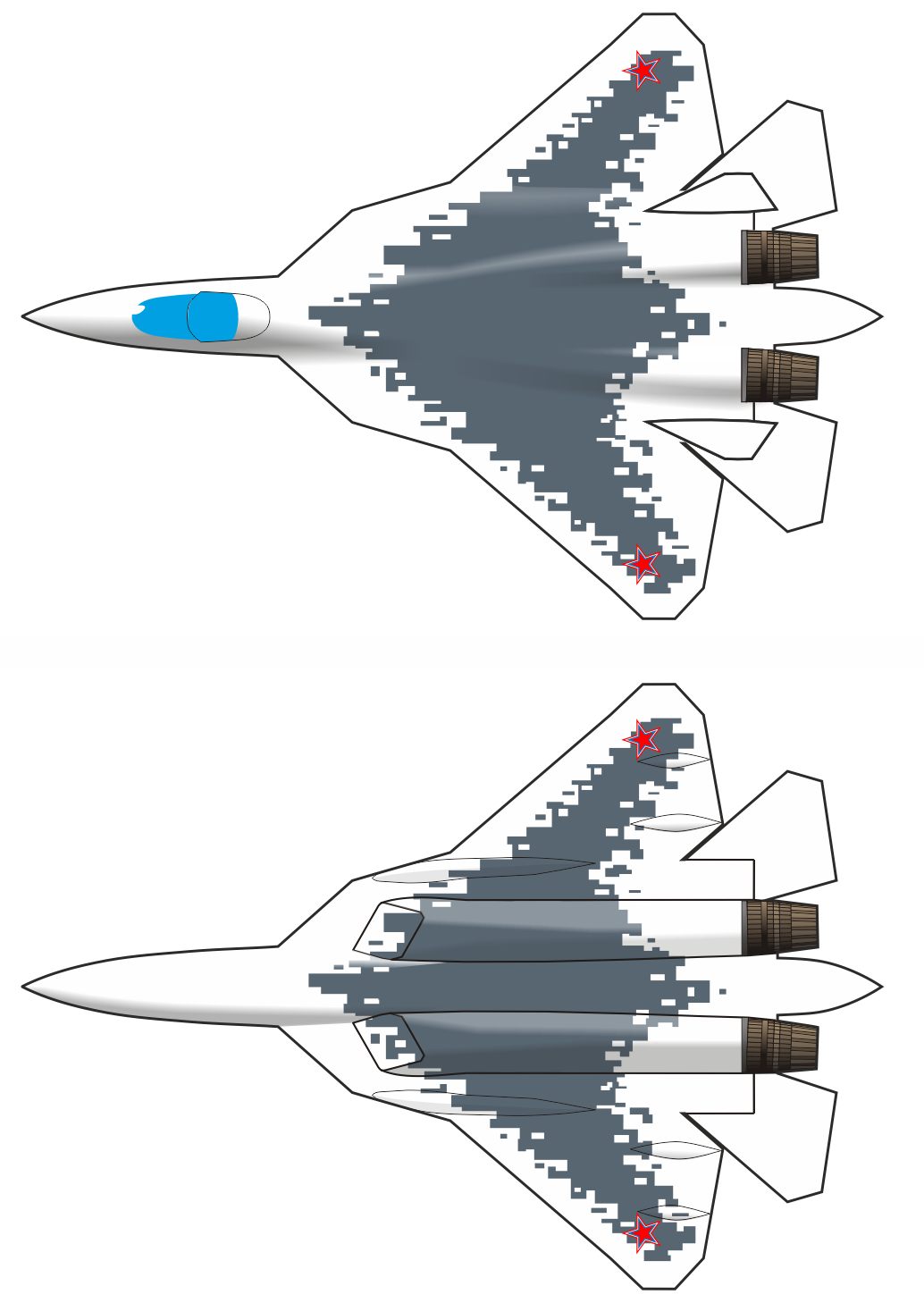
 In October 2018 rebuilded to heavy unmanned combat aerial vehicle "The Hunter" (С-70 «Охотник») programme. In October 2018 rebuilded to heavy unmanned combat aerial vehicle "The Hunter" (С-70 «Охотник») programme.
In January 2019 repainted in new stunnig scheme with pixelized S-70 "The Hunter" silhouette on top and bottom.
|
|
T-50-4
|
054
|
4th flyable prototype
|
12th December 2012
Syergyei Bogdan
|

Disruptive camouflage pattern almost the same as T-50-1, T-50-2 and T-50-3 was painted probably in January 2013. It's the last time (fourth) when that kind of camouflage was applied.
|

In January 2018 disruptive camouflage was replaced by pixel scheme on top and bottom on lightgrey background. Pixel colour is darker than applied on other aircraft.
November 2024 participated in China in Zhuhai Air Show with Bogdan. Demonstration flights.
|
|
T-50-5
T-50-5R
|
055
|
5th flyable prototype
|
27th October 2013
Roman Kondratyev
|
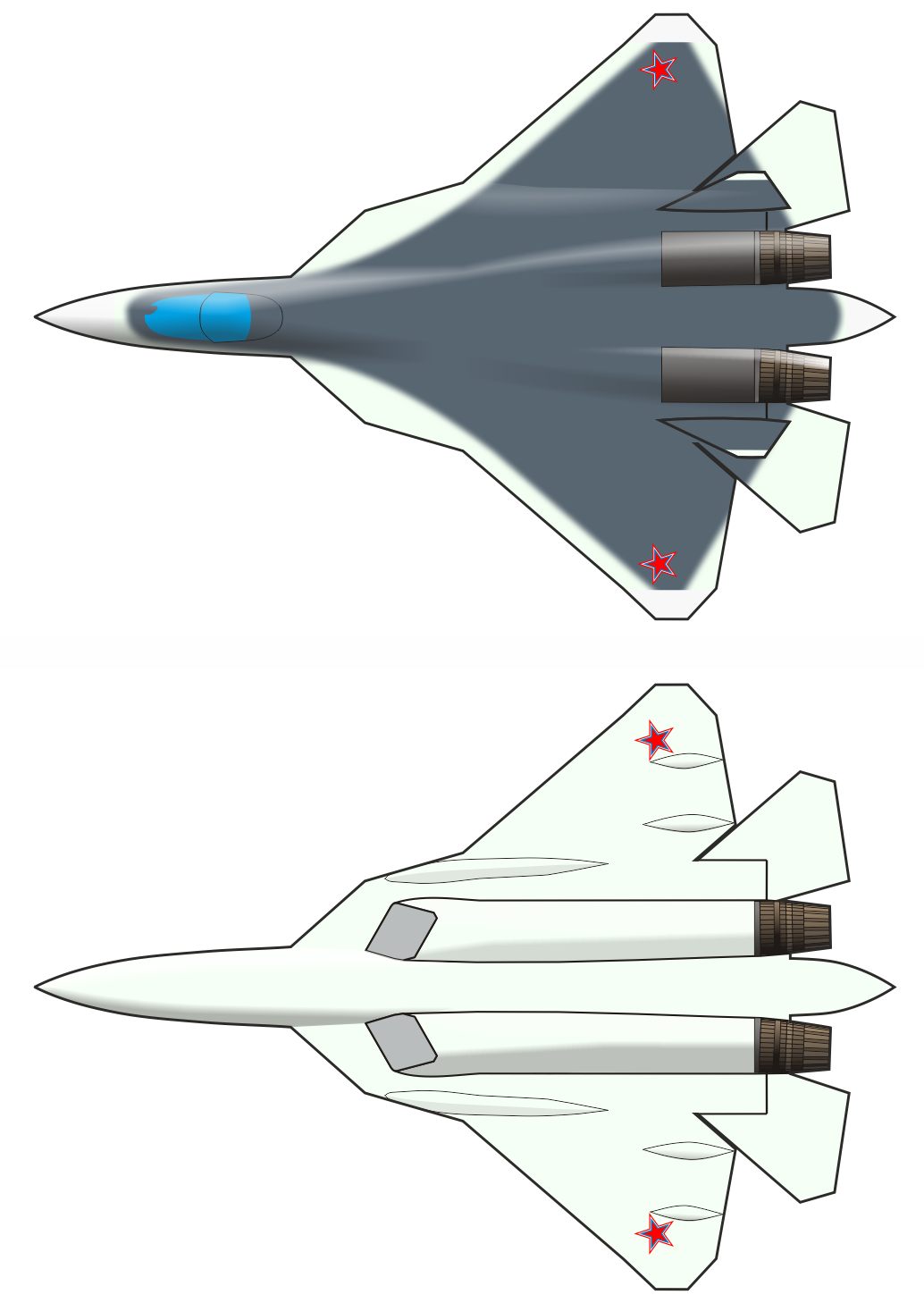
At the end of 2013 new painting scheme called «Белая акула» (White shark) was applied ONLY ONCE on T-50-5.
 Damaged by fire of the right engine in 10th June 2014 in Zhukovsky when landing, pilot Kondratyev left airplane after landing, but plane was damaged beyond repair. Was ressurected using airframe of T-50-6 and fire survived pieces (rudders, fins), renamed to T-50-5R (sufix R means ремонтный = repaired), first flight after repairs on 16th October 2015. Damaged fuselage of T-50-5 remains in Zhukovsky, wings were reused for static tests. Damaged by fire of the right engine in 10th June 2014 in Zhukovsky when landing, pilot Kondratyev left airplane after landing, but plane was damaged beyond repair. Was ressurected using airframe of T-50-6 and fire survived pieces (rudders, fins), renamed to T-50-5R (sufix R means ремонтный = repaired), first flight after repairs on 16th October 2015. Damaged fuselage of T-50-5 remains in Zhukovsky, wings were reused for static tests.
| 
2015: after repair aircraft T-50-5R was painted with new designed simplified variant of shark with sharp line between two colours.

April 2018: pixel scheme was painted on top and bottom on lightgrey background.
|
|
T-50-6
|
Unfinished because in 2014/2015 airframe was used in the reconstruction of T-50-5.
|
|
T-50-6-1
|
2015-2016
none
|
unfinished additional sixth flyable prototype
|
Ready in 2015 or 2016
|
not painted
|
 Aircraft was initially intended as additional sixth flyable aircraft of first stage to be a demonstrator to Indian FGFA programme. That's why gets name T-50-6 with suffix 1. Aircraft was initially intended as additional sixth flyable aircraft of first stage to be a demonstrator to Indian FGFA programme. That's why gets name T-50-6 with suffix 1.
Even it was called "The President", because was suppose to be the last prototype of the first stage.
Indian-Russian programme failed and even worse - unfinished T-50-6 was used in 2015 to repair T-50-5. As a result, aircraft T-50-6-1 must replace T-50-6 in PAK-FA test schedule...
|
|
T-50-7
KNS
|
2016-2018
none
|
airframe for static tests
KHC комплексный наземный стенд
|
Ready in April 2016
|
not painted
|
... but in fact, problems with weak constructive strength of first prototypes forced Sukhoi to build of further prototypes with a reinforced airframes structure. Somewhere in 2015 and 2016 aircraft T-50-6-1 became a airframe KNS for static ground tests (KHC комплексный наземный стенд = KNS) of airframe of the second stage, and was called T-50-7.
|
|
T-50-7
Su-57E
|
since 2019
057
|
non-flyable demonstrator
|
August 2019
demonstrated for the first time
|
In 2019 new scheme of camouflage was prepared: overall grey background, darkgrey pixelized silhouette on top, lightblue-grey pixelized silhouette on bottom. Scheme became standard since 2019.
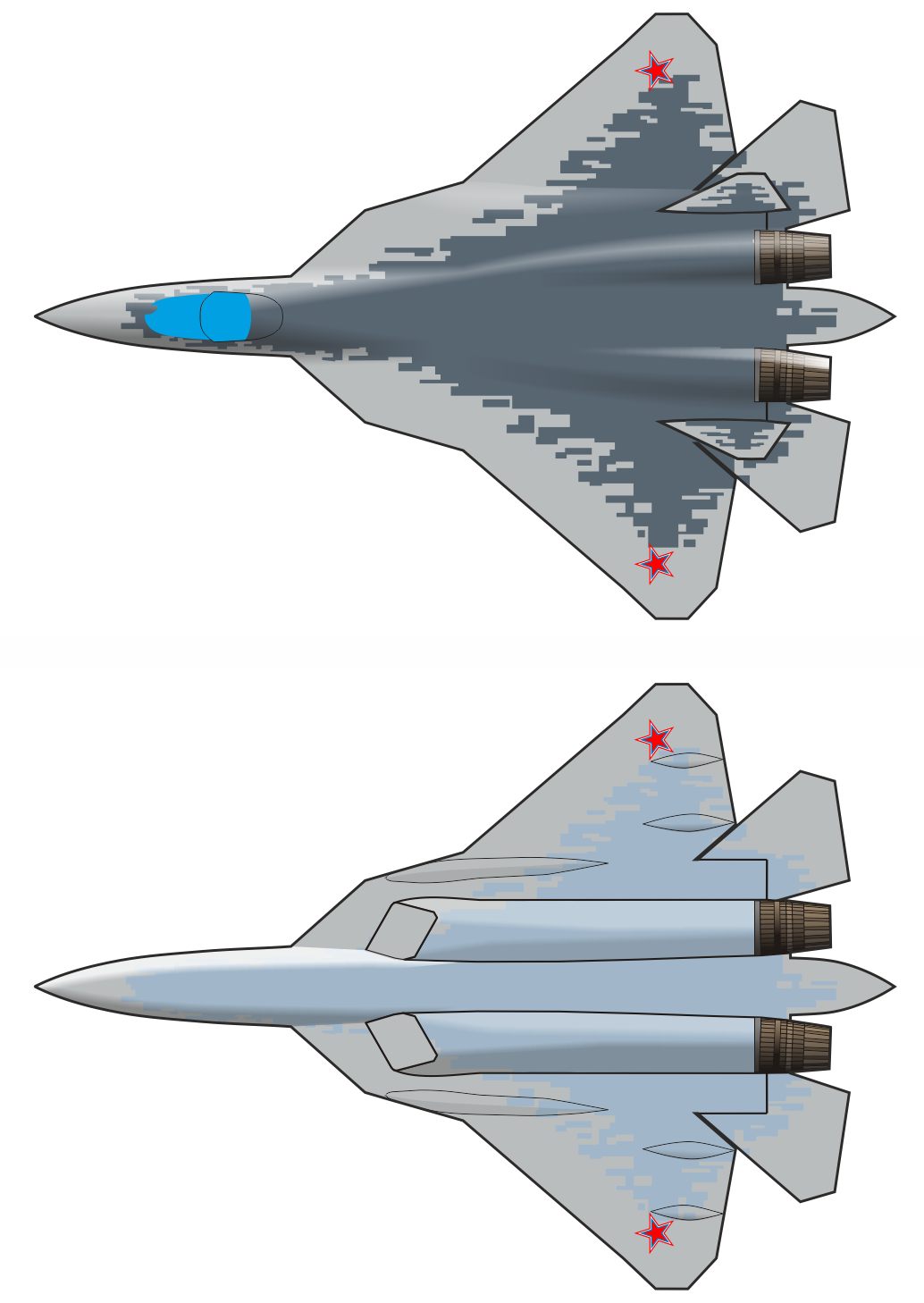
|
When static test of T-50-7 KNS was finished, non-flyable airframe was painted and equipped with mockups, including of engines "product 30" and was for the first time displayed in August 2019 at MAKS-2019 ground exhibition for Russian president Putin and Turkish prime-minister Erdoğan, later as Su-57E was offered in November 2019 at Dubai Airshow, but not displayed however. In August 2020 was displayed on static display at Army-2020 exposition. In August 2022 was displayed on static display at Army-2022 exposition.
Su-57E is somehow ridiculous, because is not fully equipped and non-flyable.
November 2024 participated in China in Zhuhai Air Show. Only static display with new armaments.
|
|
T-50-6-2
|
056
|
6th flyable prototype
|
27th April 2016
Taras Artzebarsky
|
 First prototype of second stage airframe and equipment (suffix 2), simply called T-50-6. Built simultaneusly with T-50-6-1. First prototype of second stage airframe and equipment (suffix 2), simply called T-50-6. Built simultaneusly with T-50-6-1.
Seriously changed airframe, including new tail.
|
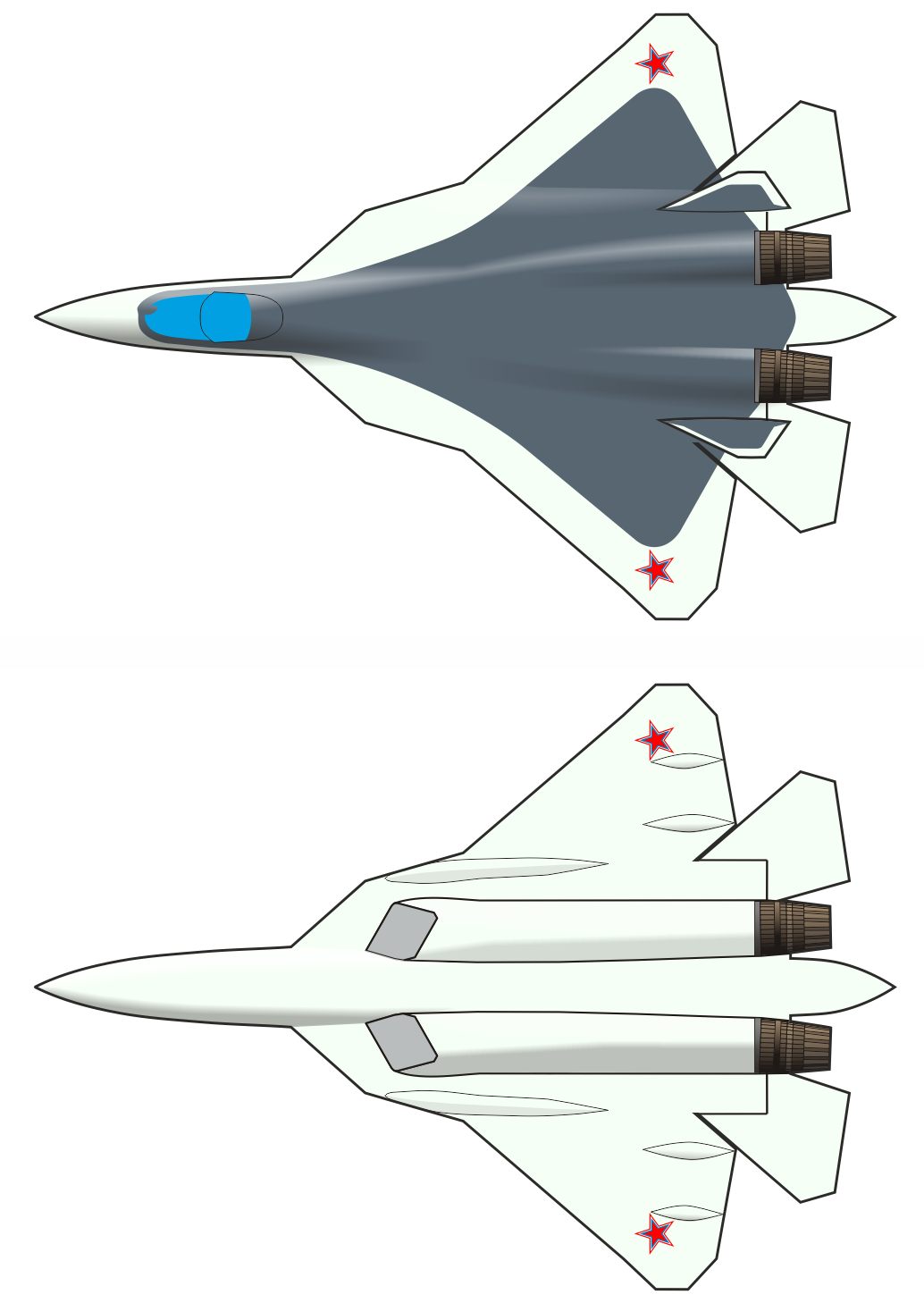
Simplified White Shark scheme was for the first time applied in 2015 on T-50-5R when aircraft was repaired after fire, then on T-50-6-2 (2016) and T-50-8 (2017). Silhouettes of shark are slightly different on each aircraft. Background is greenish.
After 2016 disappeared from public view.
|
|
T-50-8
|
058
|
7th flyable prototype
|
17th November 2016
|

Simplified White Shark scheme applied at the end of 2016 or begin of the year 2017. T-50-8 was third and last aircraft with that scheme.
|
 2018-19 strongly reworked and almost fully equipped. 2018-19 strongly reworked and almost fully equipped.
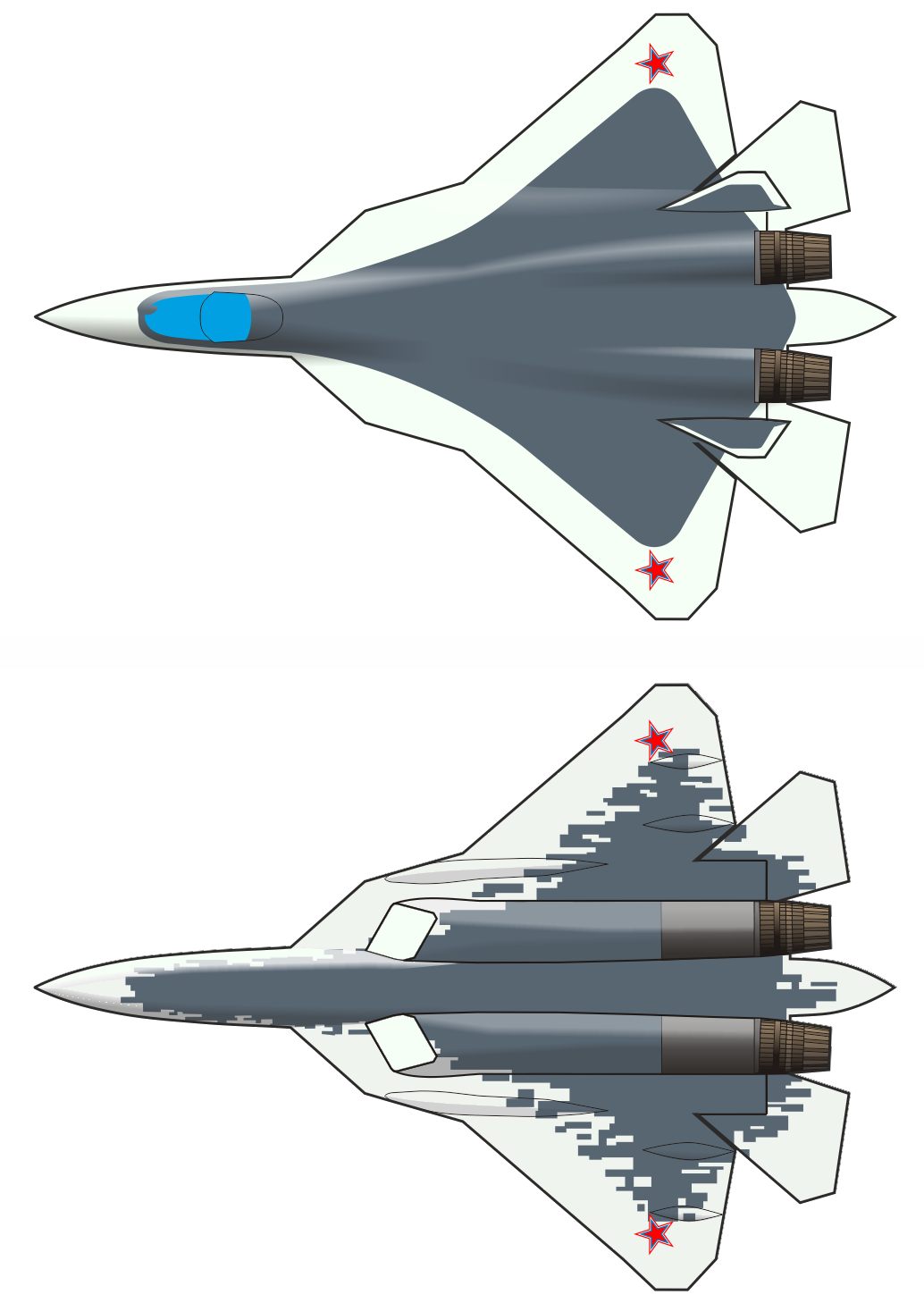
On May 2020 pixelized silhouette was added on bottom (as previously in 2018 on T-50-1, T-50-4 and T-50-5R). Greenish background on top (and bottom of course) almost disappeared because a large part of the coverage was exchanged during installation of enhanced electronic suite and rebuilding aircraft to serial configuration (most visible is new shape of air intake in pylon of the left fin to cooling and air-conditioning of engine).
|
|
T-50-9
|
509
|
8th flyable prototype
|
24th April 2017
|
2017: pixel camouflage it's a third scheme of camouflage of the Su-57, after disruptive (T-50-1, T-50-2, T-50-3 and T-50-4) and shark scheme (T-50-5, T-50-5R, T-50-6-2 and T-50-8).
Distinctive unique blueish lightgrey background.
In 2018 scheme was applied on older prototypes T-50-1, T-50-2 and T-50-4 but on top and also on bottom, on lightgrey background.
|
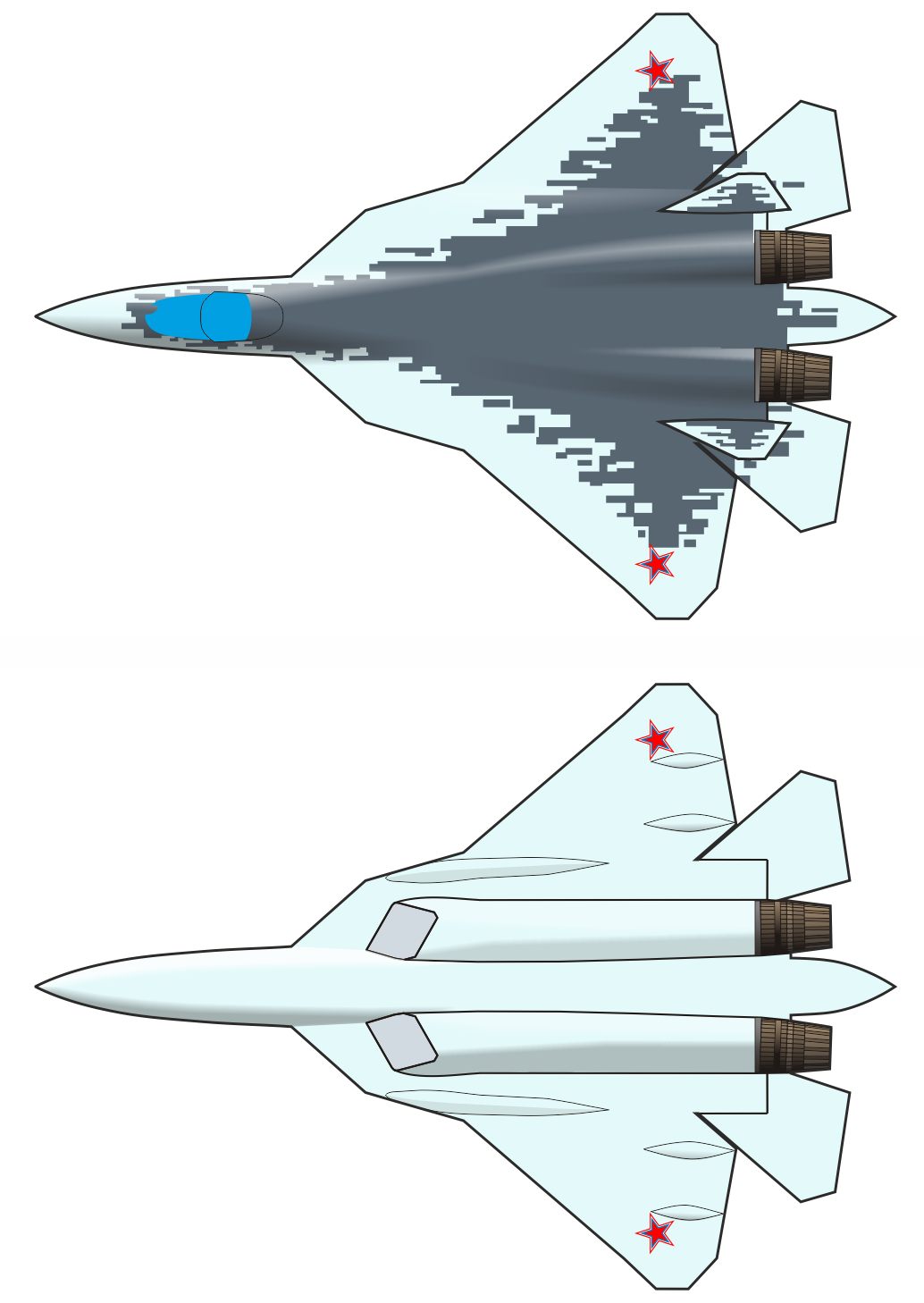
|
|
T-50-10
|
510
|
9th flyable prototype
|
23rd December 2017
|
Pixel scheme almost the same as T-50-9 but on darker grey background. Each side of fins with different pattern. Nose primarily lightgrey, then changed to grey.
Scheme applied also on T-50-11 (see below).
|
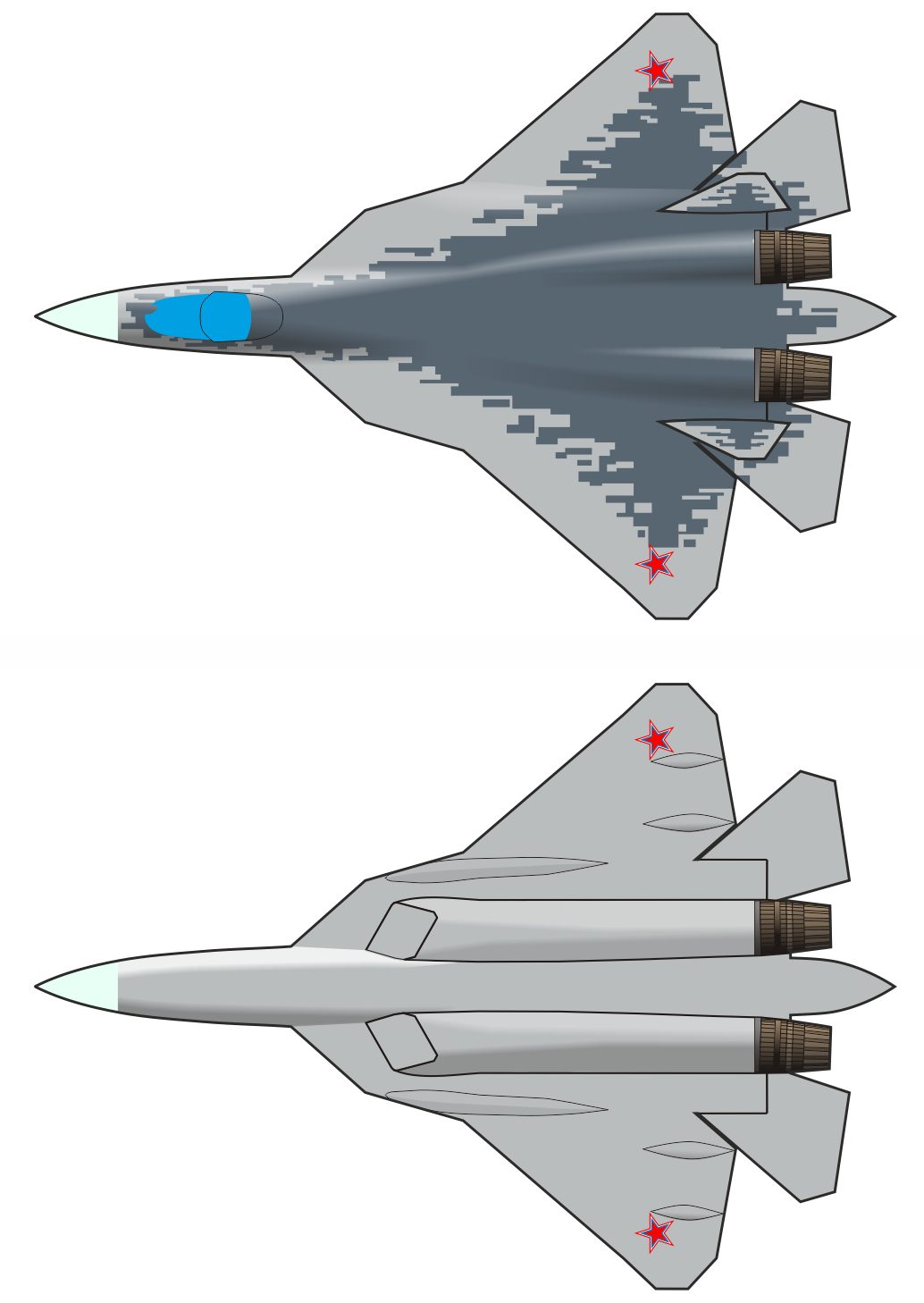
|
|
T-50-11
|
511
In March 2018 number 511 temporarily replaced by state registration
RF-81775 for abroad tests in Syria.
|
10th flyable prototype
|
6th August 2017
(earlier than T-50-10)
21st October 2022 as prototype of Megapolis second stage.
|
 Called "The President", because it's a last prototype of second stage with strengthened airframe, equipped with avionics, and should be a pattern for serial production. Called "The President", because it's a last prototype of second stage with strengthened airframe, equipped with avionics, and should be a pattern for serial production.

Painting scheme almost the same as T-50-10, but pattern on all fin's surfaces like T-50-09 prototype.
.jpg)
See also: T-50-11 with lowered LEVCON, external fuel tanks PTB-2000 and open canopy.
|

In March 2018 prototype T-50-11 was rebuilded (grey nose, new fins, Pitot probe, but still no OLS), gets state registration RF-81775 and “Russian Air Force” (BBC) on tail (it's possible that aircraft gets state registration for flight to Syria to tests). Tails were changed during test flights between 2018 and 2020.
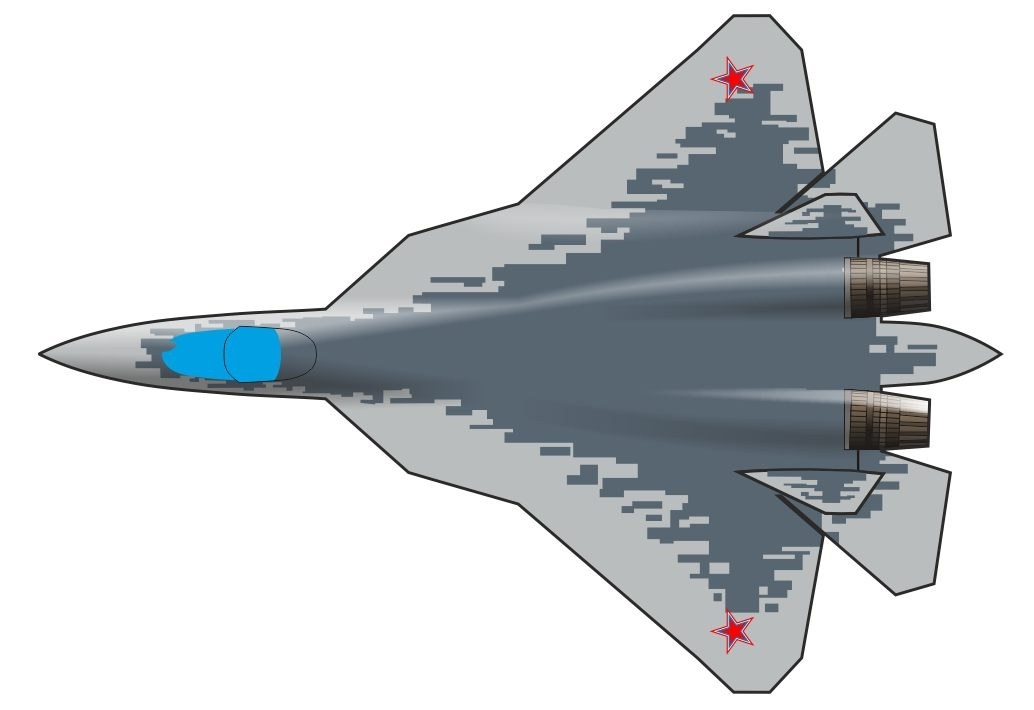
In 2022 aircraft was rebuilded to prototype of so called "second stage".
|
(Pre)serial aircraft - 51st series
|
|
T-50S-1
Factory: 51001
|
01
|
1st serial
In fact 1st of two preproduction aircraft
|
First flight:
December 2019
Crashed
24 December 2019
|

Painting of serial Su-57 is based on scheme applied for the first time on T-50-7 (former T-60-6-1) in 2019. Background is grey, pixelized silhouette on top gray and lightblue on bottom.
|
 24 December 2019 first serial Su-57 crashed near Komsomolsk-on-Amur plant airfield Dzemghi during test flight before shifted to airforce. Pilot Aleksyey Gorshkov (Алексей Горшков) ejected safely. Aircraft belongs to KnAAZ factory, was worth about 2.000.000.000 ruble (about 32.000.000 USD). It will be replaced by a new one from the company's funds. 24 December 2019 first serial Su-57 crashed near Komsomolsk-on-Amur plant airfield Dzemghi during test flight before shifted to airforce. Pilot Aleksyey Gorshkov (Алексей Горшков) ejected safely. Aircraft belongs to KnAAZ factory, was worth about 2.000.000.000 ruble (about 32.000.000 USD). It will be replaced by a new one from the company's funds.
|
|
T-50S-2
Factory: 51002
|
01 GLIC
RF-81774
|
2nd serial
In fact second of two preproduction aircraft
|
First flight:
31 October 2020
Delivered:
29 January 2021
|

|
 Serial camouflage with markings of BKC Россий (Воздушно-космические силы, Russian Aerospace Forces) and GLITs in Akhtubinsk (929-й Государственный лётно-испытательный центр Министерства обороны Российской Федерации имени В. П. Чкалова, State Flight Research Center). Third aircraft with that scheme, after T-50-7 and T-50S-1 in 2019. State registration RF-81774 since about May 2021, could be earlier. Serial camouflage with markings of BKC Россий (Воздушно-космические силы, Russian Aerospace Forces) and GLITs in Akhtubinsk (929-й Государственный лётно-испытательный центр Министерства обороны Российской Федерации имени В. П. Чкалова, State Flight Research Center). Third aircraft with that scheme, after T-50-7 and T-50S-1 in 2019. State registration RF-81774 since about May 2021, could be earlier.
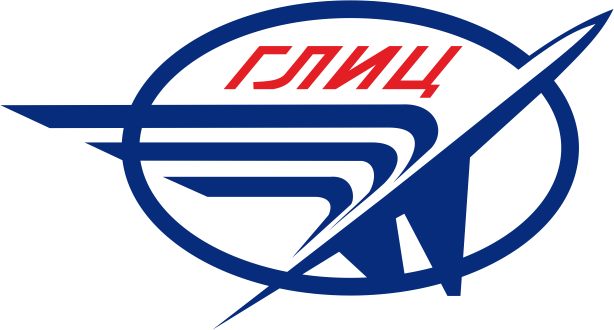
|
Serial aircraft
|
|
2021
Five serial Su-57 airplanes produced 2020-2021, delivered 2022.
|
|
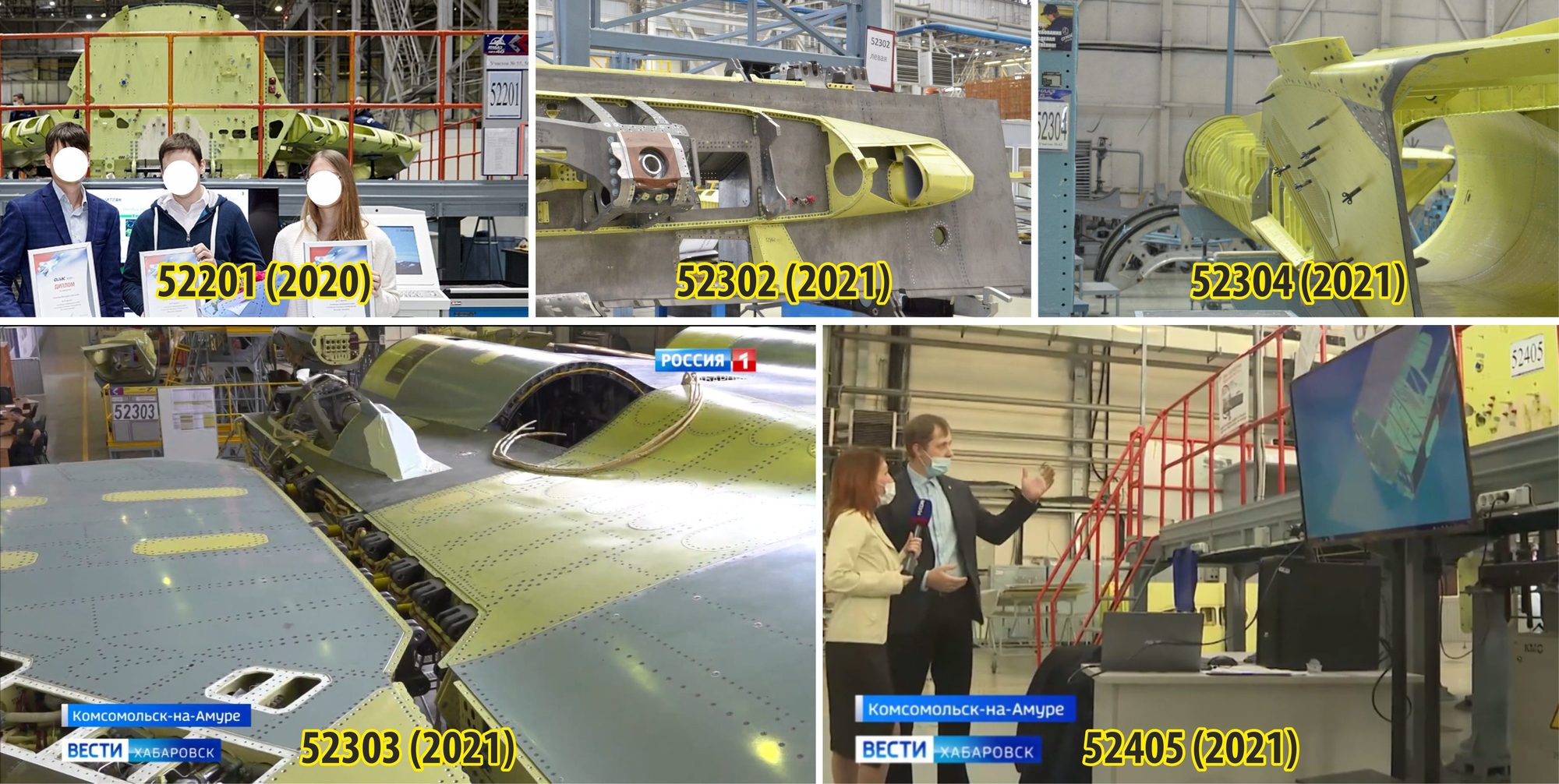
At least five aircraft were built between 2020 and 2021, with the numbers 52201, 52302, 52303, 52304 and 52405 confirmed by photos. These all are probably from the 52nd series, but three "sub-series" 2nd, 3rd and 4th, numbered successively from 01 to 05:
 52201 = 52-2-01 52201 = 52-2-01
 52302 = 52-3-02 52302 = 52-3-02
 52303 = 52-3-03 52303 = 52-3-03
 52304 = 52-3-04 52304 = 52-3-04
 52405 = 52-4-05 52405 = 52-4-05
In February 2022 were known three bort numbers, sadly unrelated with serial numbers. All in serial camouflage. When they were actually handed over to units is not known. Aircraft 52 blue appeared in reports from KNAAZ in January 2022, and two more in February 2022 - 02 (for GLIC) and 52 red. A information in bmpd LiveJournal say that is also airplane 51, what involve long internet discussions on some forums. Not only photos can confirm if that plane even exists. Possibly a fourth (or fifth if rumours about 51 are true) aircraft from 52nd series is 02 RF-81780, first time displayed in August 2023 in Army-23 exhibition. Tactical number 02 is not mistake, it's really second red 02.
Destination: fighter regiment in Dzyomghi near Komsomolsk-on-Amur (Eastern Russia), Akhtubinsk range and test center GLIC (Western Russia) and evaluation center in Lipyetsk (Western Russia).
Dzyomgi (Дзёмги) it's a base of 23-й гвардейский истребительный авиационный Таллинский полк Воздушно-космических сил = 23rd "Tallin" guards fighter air regiment of the Air and Space Forces. In Akhtubinsk in Astrakhan region (Oblast, oбласть) is main Russian military air research centre where are realised a military stage of State Acceptance Trials of each type of a aircraft - 929th State Flight Research Centre named after V. P. Chkalov, GLITs (929-й Государственный Лётно-Испытательный Центр имени В.П.Чкалова, ГЛИЦ). Centre owns a wide air range near Kazakstan border.
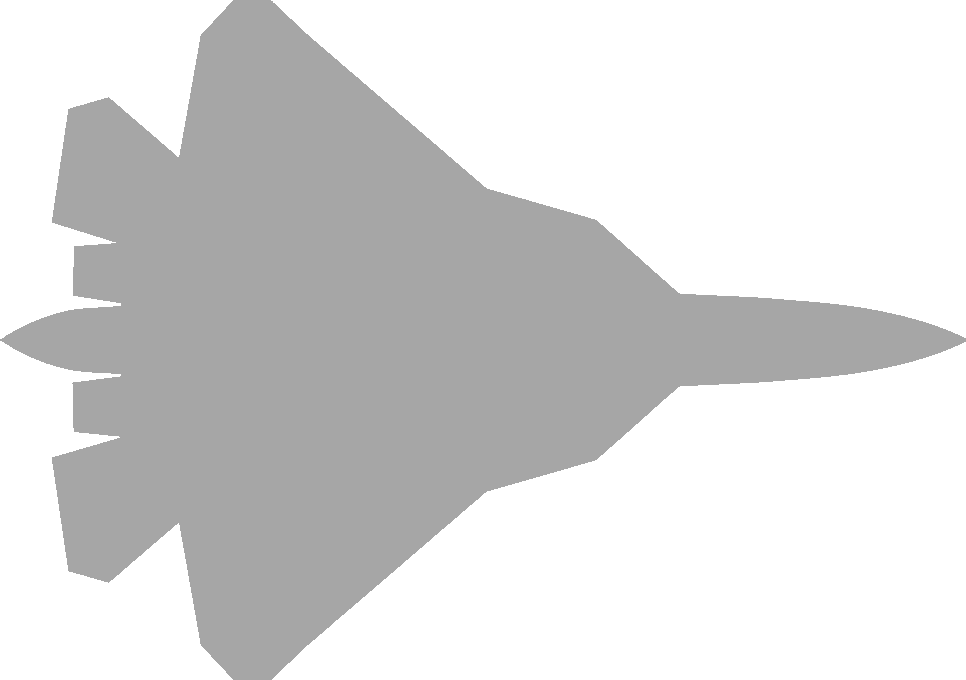 51 not confirmed 51 not confirmed
 52 without RF - Dzyomghi? 52 without RF - Dzyomghi?
 02 without RF - GLIC in Akhtubinsk 02 without RF - GLIC in Akhtubinsk
 52 RF-81775 - Lipyetsk? 52 RF-81775 - Lipyetsk?
 02 RF-81780 - Lipyetsk? 02 RF-81780 - Lipyetsk?
|
|
Six Su-57 airplanes in 2022
|
|
At the end of May 2022 two new aircraft were delivered to European part of Russia, via Tolmachevo (rus. Толмачёво), where they were spotted.
 53 RF-81777 - Lipyetsk? 53 RF-81777 - Lipyetsk?
 54 RF-81778 - Lipyetsk? 54 RF-81778 - Lipyetsk?
|
|
At the end of December 2022 four new aircraft were delivered to European part of Russia. Tactical numbers and RFs unknown, blurred on photos.
 NN RF-????? - Lipyetsk? NN RF-????? - Lipyetsk?
 NN RF-????? - Lipyetsk? NN RF-????? - Lipyetsk?
 NN RF-????? - Lipyetsk? NN RF-????? - Lipyetsk?
 NN RF-????? - Lipyetsk? NN RF-????? - Lipyetsk?
|
|
More than ten Su-57 in 2023
|
|
At the end of September 2023 four new aircraft were delivered. Tactical numbers and RFs unknown except 11 (only that one airplane appears on photos).
 11 - RF-????? - Dzyomghi? 11 - RF-????? - Dzyomghi?
 ?? - RF-????? - Dzyomghi? ?? - RF-????? - Dzyomghi?
 ?? - RF-????? - Dzyomghi? ?? - RF-????? - Dzyomghi?
 ?? - RF-????? - Dzyomghi? ?? - RF-????? - Dzyomghi?
|
|
Probably 25 December 2023, unknown number of aircraft. Russian TASS news agency says that "more than 10 were delivered in 2023", so we can suppose at least seven aircraft in December, maybe even more. In a few photos of one aircraft the numbers are blurred out, but one short video shows that the tactical number is red. Only one airplane appears on photos and video).
 ?? - RF-????? - Dzyomghi? ?? - RF-????? - Dzyomghi?
 ?? - RF-????? - Dzyomghi? ?? - RF-????? - Dzyomghi?
 ?? - RF-????? - Dzyomghi? ?? - RF-????? - Dzyomghi?
 ?? - RF-????? - Dzyomghi? ?? - RF-????? - Dzyomghi?
 ?? - RF-????? - Dzyomghi? ?? - RF-????? - Dzyomghi?
 ?? - RF-????? - Dzyomghi? ?? - RF-????? - Dzyomghi?
 ?? - RF-????? - Dzyomghi? ?? - RF-????? - Dzyomghi?
|
|
2024 deliveries
|
|
12 September 2024 few new aircraft were delivered by United Aircraft Corporation (first batch in 2024, combined delivery of Su-35S and Su-57). Tactical numbers and RF registation unknown. Two for sure, probably three aircraft.
 ?? - RF-????? - Dzyomghi? ?? - RF-????? - Dzyomghi?
 ?? - RF-????? - Dzyomghi? ?? - RF-????? - Dzyomghi?
 ?? - RF-????? - Dzyomghi? ?? - RF-????? - Dzyomghi?
|
|
11 November 2024 few new aircraft were delivered by United Aircraft Corporation (second batch in 2024, together with Su-35S). Red tactical numbers and RF registation unknown.
 ?? - RF-????? - Dzyomghi? ?? - RF-????? - Dzyomghi?
|
Events |
|
11 August 2017 | official name of the aircraft is Сухой Су-57 (Sukhoi Su-57)
|
21-23 February 2018 | two prototypes deployed to Syria for quick two-days tests in real combat environment. Next unspecified tests in real combat environment in December 2018.
|
August 2018 | contract for 12 Su-57 (so called pre-production series) to prepare service routines in center of combat application in Lipetsk. In fact it's a payment to Sukhoi for 10 flyable prototypes (except first KNS and second KNS/Su-57E) and two preproduction aricraft.
|
|
|
June 2019 | contract for 76 aircraft signed during International Military and Technical Forum "Army-2019" (Международный военно-технический форум «АРМИЯ-2019»). Aircraft for three regiments (24+24+24) and four in Lipyetsk center.
|
27th September 2019 | first flight of Su-57 (T-50-5) and UAV S-70 "The Hunter".
|
November 2019 | first serial Su-57 (T-50S-1, factory number 51001) assembled in KNAZ factory (one of two preproduction aircraft). Second aircraft expected in 2020, and next 74 until 2027.
|
4 December 2019 | first serial Su-57 crashed near Komsomolsk-on-Amur factory airfield Dzemghi during test flight before shifted to airforce.
|
December 2020 | serial Su-57 (T-50S-2, factory number 51002) was delivered to Russian Aerospace Forces and will begin service with one of the aviation unit of the Southern Military District. In 2021 it will undergo a series of military tests on the firing range in Akhtubinsk in 929th State Flight Research Center named after V. Chkalov (GLITs). New engines "product 30" are expected only in 2022...
|
December 2020 / January 2021 | S-70 undergoing tests on Ashuluk fire range.
|
End of 2020 | in KnAAZ factory augmented reality is using to assist with the assembly of the aircraft.
|
29th January 2021 | first serial Su-57 (T-50S-2) officially (?) handed to Russian Aerospace Forces (GLITs).
|
Since end of 2022 | 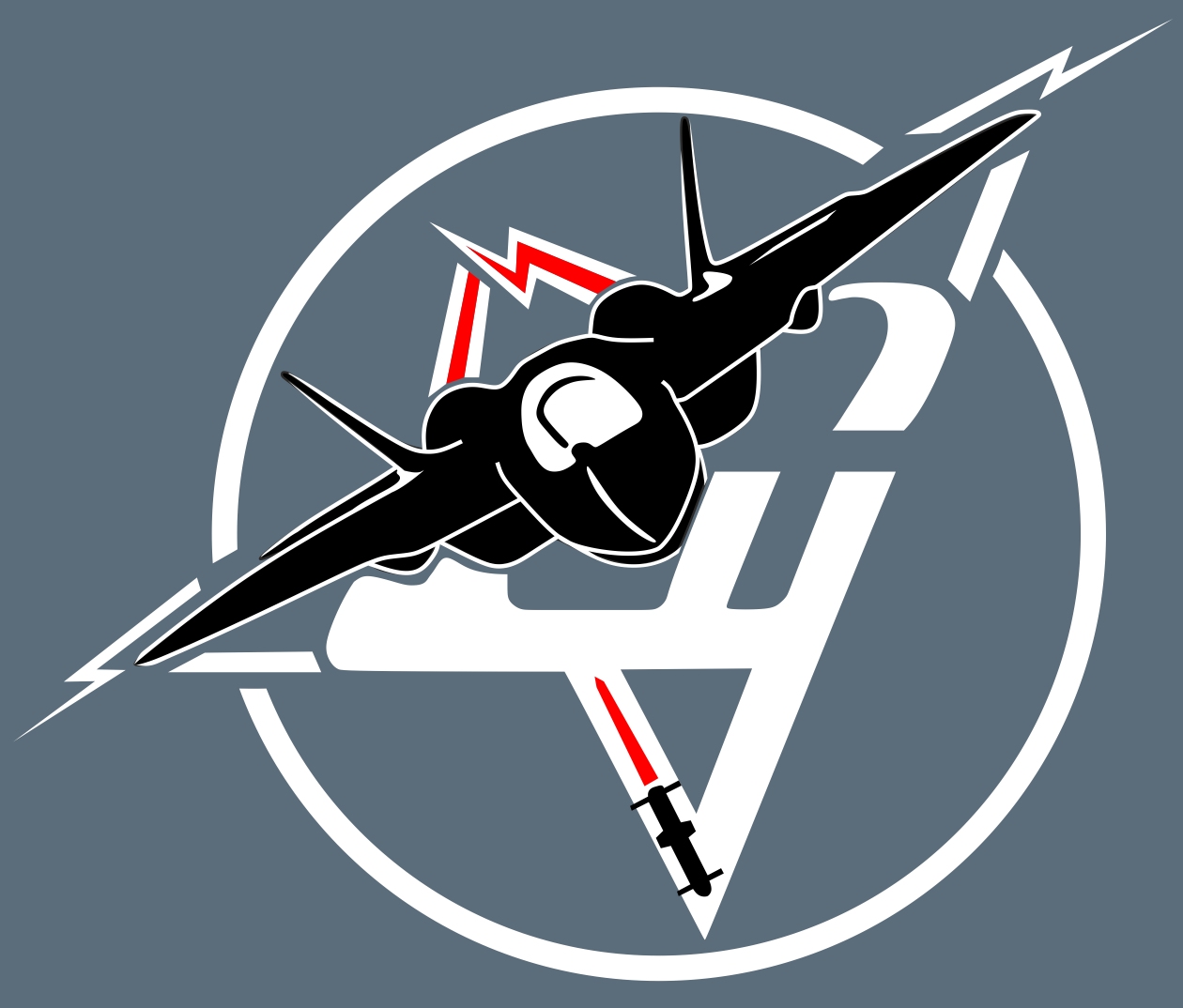  Modernised Su-57 is tested with new avionics, weapons and fitted to new engines - prototype 511 (maiden flight 21st October 2022) and later also 058 join the programme. It's a second stage of development called Megapolis. Modernised Su-57 is tested with new avionics, weapons and fitted to new engines - prototype 511 (maiden flight 21st October 2022) and later also 058 join the programme. It's a second stage of development called Megapolis.
21 October 2022 first flight of the upgraded Su-57 aircraft took place at the Gromov LII airfield. The aircraft was piloted by Sukhoi Design Bureau's test pilot, Hero of the Russian Federation, Sergey Bogdan. The aircraft (well known prototype T10-11 with number 511) is being tested with a set of onboard equipment with enhanced functionality, intelligent crew support and the ability to use a wide range of new types of weapons. The aircraft is also capable of installing a second-stage engine (the engines of the second stage "product 30" have not yet been installed). On photos are visible new larger window of 101KS Atoll optronic system (on left sie of the fuselage, on roght side not installed at all and the window is blinded). Also visible are night navigation lights.
The development of a modernised version of the Su-57 Second Stage is a part of the Megapolis development work (ОКР, опытно-конструкторская работя «Мегаполис»). The state contract was signed by the Russian Ministry of Defence and Sukhoi Company PJSC on 29 October 2018.
|
2023 | It's possible that Su-57 is used in combat in Ukraine.
|
14 March 2023 | Александр Николаевич Давиденко (Alexander Nikolayevitch Davidenko) passed away 14th March 2023.
|
26 December 2023 | "The state defence order (Государственный оборонный заказ, ГОЗ) for the Su-57 fifth-generation fighter in 2023 has doubled, and the order for 2024 is even larger". This was announced by the head of the United Aircraft Corporation (UAC, part of Rostec; Объединенная авиастроительная корпорация, ОАК, Ростех) Yury Slyusar (Юрий Слюсарь) in an interview with Rossiya-24 TV channel. "We have fulfilled the state defence order. Everything that was stipulated by the signed contracts and schedules has been delivered on time, sometimes even ahead of schedule for some plants. (...) Our orders have increased at all plants, some of them quite significantly. As for new aircraft: the order for the Su-57 aircraft has literally doubled" he said when asked about the corporation's results within the framework of fulfilment of the State-Owned Aircraft Order of the previous year. Slyusar noted that the Su-57 fighter is a difficult machine to manufacture, but UAC handled its delivery to the customer with honour. "For 2024, the order is even bigger, there is even more work" he added.
Slyusar did not say exactly how many of the newest fighters the Russian army has received.
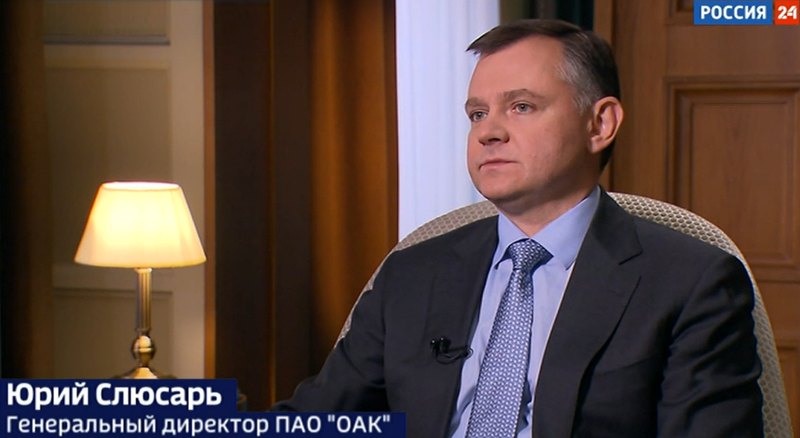
|
December 2023 | If is true that deliveries of Su-57 were doubled in 2023 (more than 10, even up to 14), is possible that in service is enough aircraft to form first fully equipped squadron (12 aircraft).
|
December 2023 | The Isdyelie 30 engine has passed all tests. All aircraft that will be delivered in 2024 will be equipped with new engines, which will reportedly be designated AL-51. Those delivered between 2020 and 2023 will not receive new engines.
|
5th May 2024 | Su-57 damaged by long range strike in Akhtubinsk airfield. Ukrainian missiles or drones? Also range of damages is unknown.
|
November 2023 | engine AL-51 will be displayed in China Zhuhai Air Show. One SU-57 (054) is displayed be pilot S. Bogdan in demonstration flights, another (057 transported aboard an An-124 cargo aircraft) in static display. Reports from BulgarianMilitary.com point out that the Su-57s presented at the show featured bolts along their fuselage and wings, instead of rivets typically found on stealth aircraft. This detail has led to debate, with some asserting that combat-ready Su-57s utilize rivets for improved stealth, while the bolts may only be used on show models. Such a distinction raises questions about the real-world stealth capabilities of Russia’s production Su-57s, especially given the demanding requirements for radar evasion in modern combat environments.
|
Some technical features
|
| два двигателя АЛ-41Ф-1
| two engines AL-41F-1
| A total of 38 AL-41F-1 engines were manufactured and used in PAK-FA/Su-57 programme until 2018 (engine was invented in 2004): 2 for T-50-KNS, 3 for static endurance testing, 2 for static special testing, 30 for 10 flying prototypes and 1 for state static tests in 2017 (official ending act was signed 17th April 2018). Since March 2018 all engines have worked a total of 18,000 hours.
|
| ВСУ вспомогательная силовая установка cистема запуска двигателя АЛ-41Ф-1
| APU auxiliary power unit for ingnition system of AL-41F-1 engines
| It's not a well-known ГТДЭ Газотурбинный двигатель-энергоузел - gas turbine GTDE-117-1 produced by Санкт-Петербургское OAO «Красный Октябрь» [“Red October”, Petersburg], but new more powerful modular unit with 120 kW power. It's a single* unit located in right engine compartement, to simplified construction and maintenance of aircraft, mounted on ВКА Выносная коробка приводов самолетных агрегатов [VKA external accessory gearbox]. On the ground APU supply compressed air (0,55 kg/sec) and up to 30 kVA energy to plane systems. In flight mode ЭНЕРГОУЗЕЛ [energy knot] produce electricity (16 kVA) to air-conditioning systems of cabin and produce 115/200 V AC to onboard networks. Important is that one APU can start both engines.
* According to 2018 Lyulka OKB booklet.
|
| Головка приемника топлива серии ГПТ-2Э
| nozzle assembly of the GPT-2E
| Universal refueling nozzle conform both to the RF and NATO standards. Maximum refueling rate is up to 2500 l/min. Produced by Научно-производственное предприятие «Звезда» [Scientific-Production Enterprise “Zvezda”, Tomilino].
|
ШКАИ широкоугольный коллиматорный авиационный индикатор
(ИЛС индикатор на лобовом стекле)
| ShKAI wide-angle collimator head-up display (HUD)
| Developed by Санкт-Петербургское опытно-конструкторское бюро «Электроавтоматика» имени П.А. Ефимова [Sankt-Petersburg Experimental Design Bureau “Electroautomatica” named after P. A. Yefimov].
|
| Остекление кабины (Фонарь) - Передний козырек (ПЧФ передняя часть фонаря) и ОЧФ откидная часть фонаря
| PChF windshield and OChF canopy
| In serial aircraft are made from silicone and hydrocarbonate respectively. Manufactured by ОНПП Обнинское научно-производственное предприятие «Технология» им. А. Г. Ромашина [Obninsk Research and Production Enterprise “Technology” named after A.G. Romashin]. In 2020 T-50-8 performed successful flight tests without the canopy.
|
| катапультное кресло К-36Д-5
| ejection seat K-36D-5
| Developed in 2011 by Научно-производственное предприятие «Звезда» [Scientific-Production Enterprise “Zvezda”, Tomilino].
|
| унифицированный защитный шлем ЗШ-10
| unified protective helmet ZSh-10
| Developed in 2011 by Zvezda. In 2018 were developed improved versions.
|
| противоперегрузочный костюм ППК-7
| anti-G pilot's suit PPK-7
| Full-body costume tested by Sukhoi since 2018, developed by Zvezda.
|
| Кислородная система КС-50
| oxygen system KS-50
| Developed by Zvezda. Supply oxygen at the attidude up to 23.5 km. The oxygen source is the BKDU-50 onboard oxygen-generating system producing oxygen from the compressed air tapped from the aircraft gas turbine compressor.
|
| ПТК-50 тормозная посадочная парашютная система
| PTK-50 brake landing parachute system
| Developed by Научно-исследовательский институт парашютостроения [Scientific Research Institute of Parachute Contruction, Moskva].
|
| устройствa выброса ловушек и помех ЛТЦ (Ложные тепловые цели)
| CFD chaff and LTC flare dispensers
| Located in tail - two on top, one in bottom.
|
| ННПУ-50 пушечная установкa
| NNPU-50 gun installation
| With built-in 9-A1-4071K gun, developed from Gryazev-Shipunov ГШ-301 GSh-301). One-barrel cannon 30mm calibre with 150 projectiles and independent water-evaporating cooling system of the barrel. Developed in 2014 by КБП «Конструкторское бюро приборостроения им. академика А. Г. Шипунова» [KBP Instrument Design Bureau named after Academician Arkady Georgevich Shipunov, Tula city].
АКУ-170E, АКУ-620E Авиационное катапультное устройство
УВКУ-50У, УВКУ-50Л Универсальная внутрифюзеляжная Катапультная установка
| APU air catapult device
UVKU universal in-fuselage catapult installation (launcher)
| Six external hard points under air intakes fuselage and wings, two internal weapon bays between engine nacelles and two below LERX. Missile launchers are of the catapult (something lika pantograph or scissors) type, allowing the missile to be lowered slightly before firing. Designed by АО ГосМКБ (Государственное машиностроительное конструкторское бюро) «Вымпел» им. И.И.Торопова [GosMKB State Machine Building Design Bureau "Vympel" named after I.I. Toropov, Moskva], produced by Корпорация «Тактическое ракетное вооружение», Королёв [Tactical Missiles Corporation, Korolev city, Moskow region].
|
| Пиксельная окраска
| Pixel camouflage
| “Gives the effect of a blurred outline, which distorts the clear boundaries of the aircraft” says Mikhail Strelets, chief designer of the Su-57 and general director of Sukhoi Design Bureau.
|
|
17th February 2021: purpose of some details is hipothetical or unknown. Well, still classified...
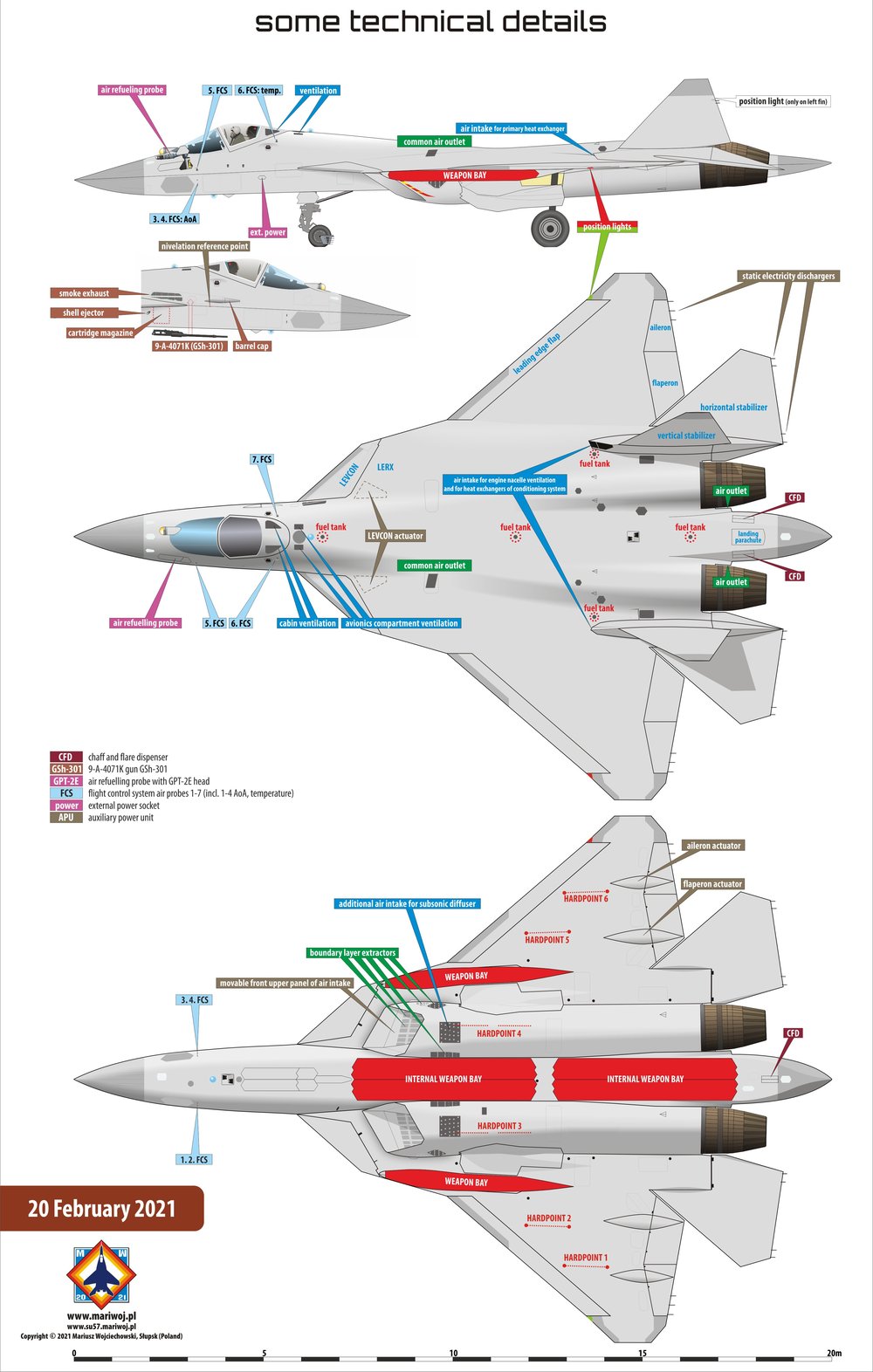
| |
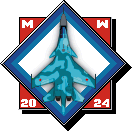
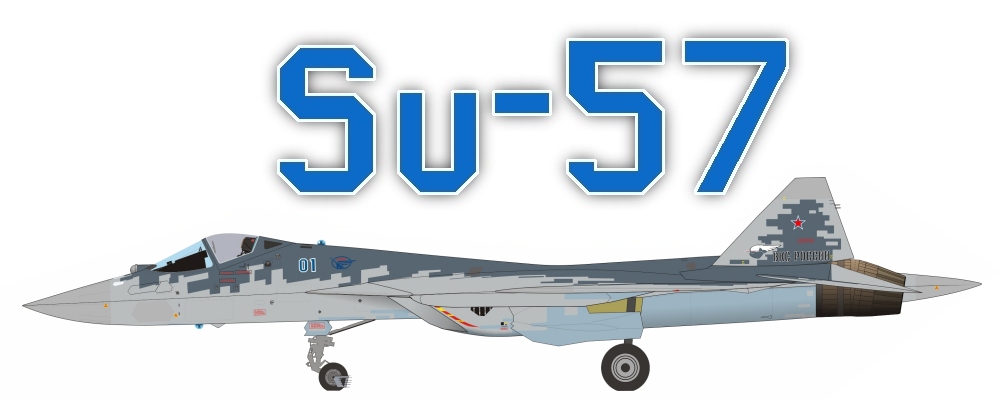
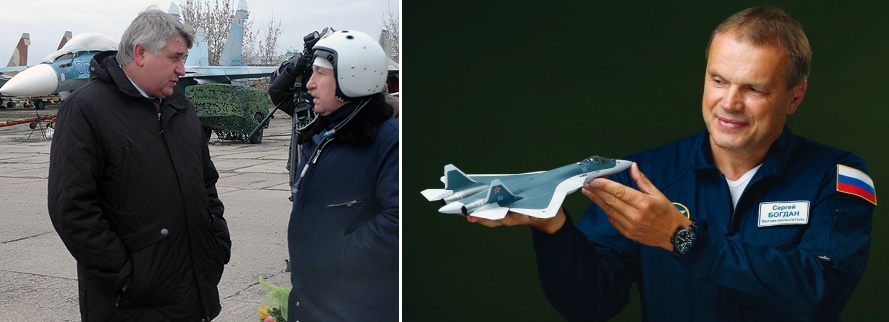
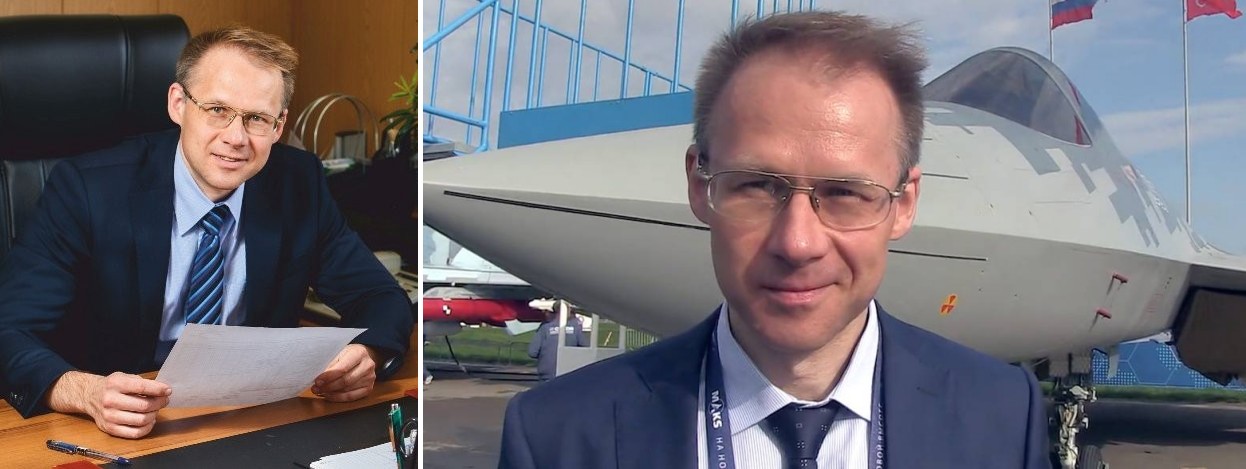











.jpg)





